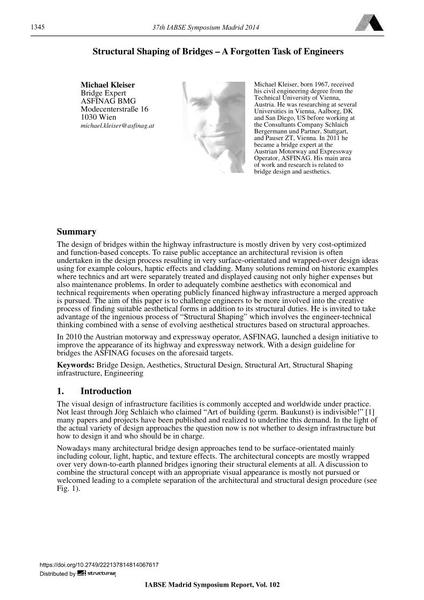Structural Shaping of Bridges – A Forgotten Task of Engineers

|
|
|||||||||||
Détails bibliographiques
| Auteur(s): |
Michael Kleiser
|
||||
|---|---|---|---|---|---|
| Médium: | papier de conférence | ||||
| Langue(s): | anglais | ||||
| Conférence: | IABSE Symposium: Engineering for Progress, Nature and People, Madrid, Spain, 3-5 September 2014 | ||||
| Publié dans: | IABSE Symposium Madrid 2014 | ||||
|
|||||
| Page(s): | 1345-1352 | ||||
| Nombre total de pages (du PDF): | 8 | ||||
| Année: | 2014 | ||||
| DOI: | 10.2749/222137814814067617 | ||||
| Abstrait: |
The design of bridges within the highway infrastructure is mostly driven by very cost-optimized and function-based concepts. To raise public acceptance an architectural revision is often undertaken in the design process resulting in very surface-orientated and wrapped-over design ideas using for example colours, haptic effects and cladding. Many solutions remind on historic examples where technics and art were separately treated and displayed causing not only higher expenses but also maintenance problems. In order to adequately combine aesthetics with economical and technical requirements when operating publicly financed highway infrastructure a merged approach is pursued. The aim of this paper is to challenge engineers to be more involved into the creative process of finding suitable aesthetical forms in addition to its structural duties. He is invited to take advantage of the ingenious process of “Structural Shaping” which involves the engineer-technical thinking combined with a sense of evolving aesthetical structures based on structural approaches. In 2010 the Austrian motorway and expressway operator, ASFINAG, launched a design initiative to improve the appearance of its highway and expressway network. With a design guideline for bridges the ASFINAG focuses on the aforesaid targets. |
||||
| Mots-clé: |
esthétique
|
||||
